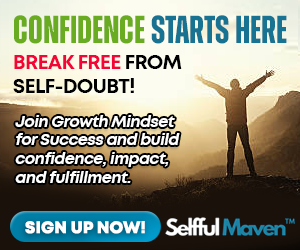Let’s be real—few things feel more awkward than being asked, “So, tell me about yourself.”
Whether you’re at a networking event, job interview, first date, or even just introducing yourself in a Zoom meeting, that question can trigger a silent panic. What do you say? How much do you say? Will they think you’re bragging—or worse, boring?
If you’ve ever fumbled through that moment, you’re not alone. But the truth is, how you introduce yourself can either open doors—or keep them closed. And the best part? Confidence isn’t something you’re born with. It’s something you build—and it starts with a mindset shift.
Welcome to Selfful Maven, where we help you tap into your power, own your story, and show up with purpose.
Why the Way You Introduce Yourself Matters
People form first impressions in less than 7 seconds. In that short window, they’re subconsciously asking:
- Can I trust this person?
- Do they seem competent?
- Are they confident?
If your introduction is timid, vague, or overly rehearsed, you risk coming across as inauthentic. But when you introduce yourself confidently, you command attention, establish credibility, and open the door to meaningful connections.
First impressions are powerful. They influence whether you get hired, whether someone wants to work with you, and even how people treat you. The good news? You don’t need to be loud or extroverted to make a great one. You just need to show up as your authentic, empowered self.
So, let’s talk about how to introduce yourself in a way that feels natural, powerful, and aligned with your highest self.
How Do You Introduce Yourself With Confidence?
Let’s break it down into a simple, powerful 3-part framework that you can use anywhere:
1. Start With Who You Are (But Keep It Real)
Skip the generic “Hi, I’m Sarah and I work in marketing.” Instead, say something like:
“Hi, I’m Sarah. I help brands turn ordinary content into unforgettable storytelling.”
See the difference? That small shift shows purpose and passion.
This approach gives your name context. You’re not just telling someone what you do—you’re telling them why it matters.
💡 Tip: Keep it short, but don’t hide behind your job title. You are more than your role.
2. Share What Lights You Up
Confidence is magnetic. When you talk about what drives you, people naturally lean in. Whether it’s helping others, solving problems, or making people laugh—say it out loud.
“What lights me up is helping people discover the mindset shifts that unlock their true potential.”
Now you’re not just a name—you’re a mission.
This part helps people remember you. Emotion is sticky. When you share what you’re passionate about, you’re planting a seed in someone’s memory.
3. End With Connection or Curiosity
Want to build instant rapport? Turn the spotlight back on them.
“What about you? What got you interested in this field?”
or
“Have you always been passionate about what you do?”
Asking questions shows confidence and builds trust. It also turns a monologue into a dialogue—which is where real connection happens.
Real-Life Examples of Confident Introductions
Here are a few confident, authentic examples you can model in different settings:
Professional Networking Event:
“Hi, I’m Marcus. I lead strategy at a fintech startup helping small businesses simplify their cash flow. I’m passionate about making money management less intimidating. What brought you here today?”
Job Interview:
“I’m Alicia. Over the last five years, I’ve led digital campaigns that increased online engagement by 60% for mission-driven brands. I love building communities around causes that matter.”
Online Meeting or Zoom Call:
“Hi everyone! I’m Jamal. I support entrepreneurs by helping them clarify their vision and execute with focus. I’m here to learn from you all and share what’s worked for my clients.”
Social Gathering or First Date:
“I’m Taylor. I’m a yoga teacher and writer, and I’m really passionate about helping people find balance through mindful movement. What kind of things light you up?” Notice that each example follows the 3-part framework: clear introduction, passion, and curiosity.
Common Mistakes to Avoid When Introducing Yourself
Even the most confident people fall into these traps:
🚫 Overexplaining or rambling
🚫 Underselling or apologizing for themselves
🚫 Using vague or buzzword-heavy language
🚫 Avoiding eye contact or slouching
🚫 Speaking too fast or too softly
Here’s how to counter those habits:
✅ Practice your introduction out loud (but don’t memorize it word-for-word)
✅ Stand or sit tall—body language boosts confidence
✅ Slow your speech just slightly—this signals calm authority
✅ Replace filler words with pauses (it’s OK to breathe!)
✅ Smile—it builds warmth and trust instantly
What If You’re an Introvert?
Let’s bust a myth: Introverts can be just as confident (if not more) than extroverts.
Confidence is about being secure in who you are—not being the loudest in the room.
If you’re introverted, use that to your advantage:
- Reflect on your introduction before events
- Prepare powerful questions to ask others
- Leverage one-on-one conversations
- Focus on depth over volume
People don’t remember noise—they remember presence. And presence is something introverts often excel at.
Confidence Starts With Mindset
Let’s be honest—confidence doesn’t come from memorizing a script. It comes from within.
If you struggle with imposter syndrome, self-doubt, or fear of judgment, it’s not your fault. You’ve just been conditioned to stay small.
But it’s time to unlearn that.
That’s exactly why I created my signature course:
Growth Mindset for Success – The Key to Confidence, Impact & Fulfillment
In this transformational course, you’ll learn how to:
- Rewire your self-talk and internal beliefs
- Speak with clarity, power, and presence
- Show up in any room like you belong—because you do
- Develop a growth mindset that fuels long-term confidence
Whether you’re leveling up in your career, launching a business, or just want to stop playing small, this course is your next step.
Click here to enroll now and start introducing yourself with bold, authentic confidence.
10 Prompts to Practice Introducing Yourself Confidently
To help you implement what you’ve learned, here are some journal prompts and speaking exercises you can use:
- What makes you unique in your work or life?
- What are three things you’re proud of accomplishing?
- How do you want people to feel after meeting you?
- What lights you up—and how can you express that?
- What question do you love asking people when you first meet them?
- What’s one story you can tell that reflects who you are?
- How do your friends describe you?
- What’s the legacy you want to leave?
- How do you define confidence in your own words?
- What would you say if you knew you couldn’t fail?
The more you explore these questions, the more naturally your self-introduction will flow.
Final Thoughts: You Deserve to Be Heard
Learning how to introduce yourself confidently isn’t just a “nice to have.” It’s a life skill that will impact every relationship, opportunity, and success story you create.
So the next time someone says, “Tell me about yourself,” don’t shrink.
Smile. Breathe. Speak your truth.
Because when you believe in yourself, the world does too.
Ready to become unforgettable every time you speak? Join the Selfful Maven movement and start your journey here: Growth Mindset for Success
And if this article helped you, share it with someone else who needs a little confidence boost today. You never know who’s waiting to hear your voice.





